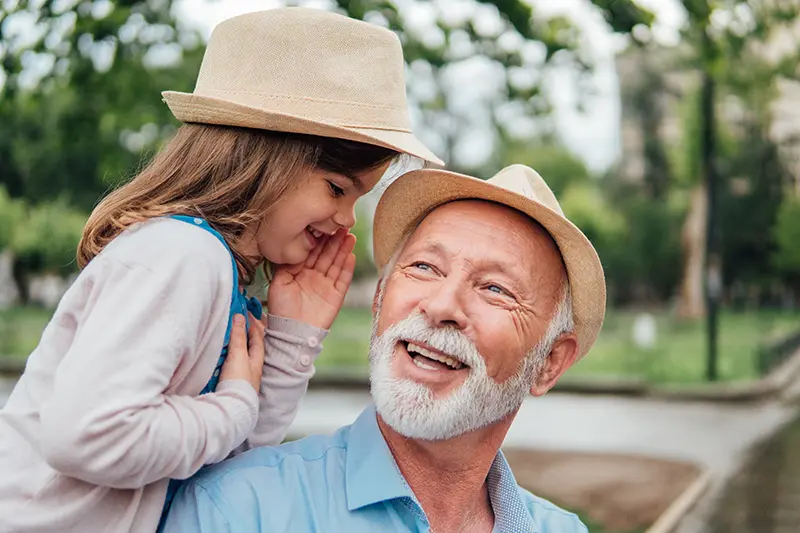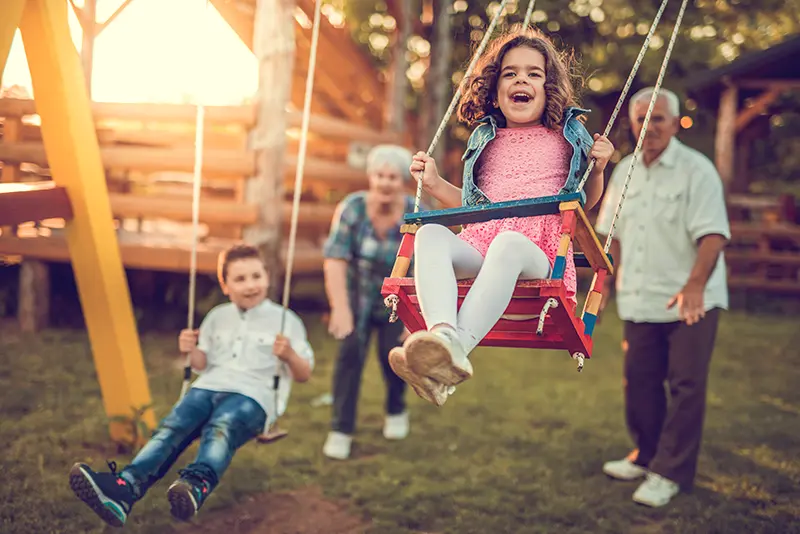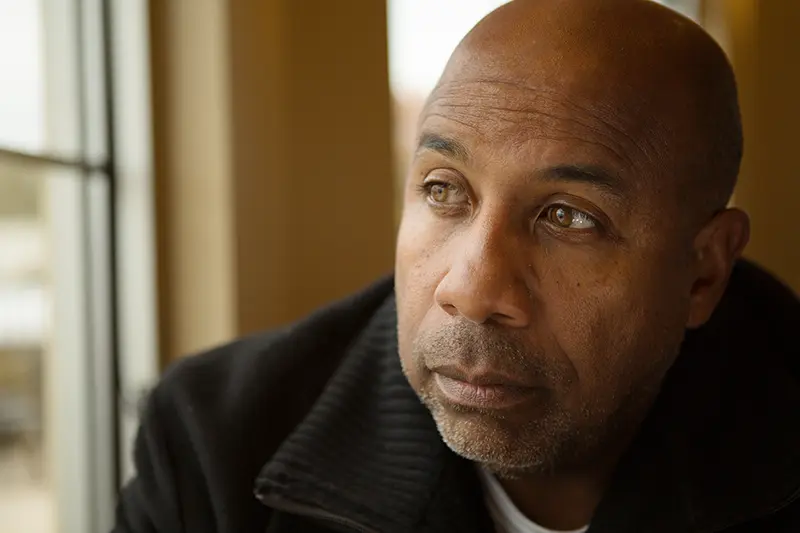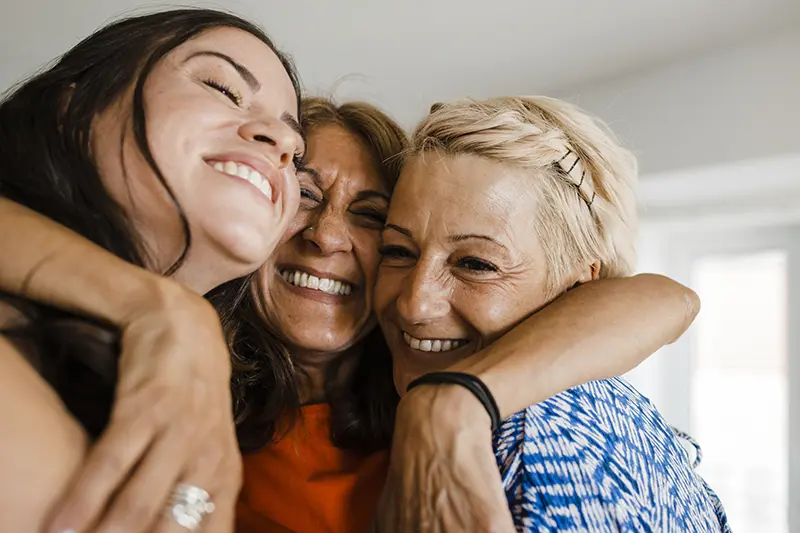Connections

My huge, wonderful family. Especially my #1 Daughter and # 1 granddaughter. I am the great great grandfather.
Male, 771 in response to being asked what contributes to his overall well-being
- 60% Married; 64% of 50s, 63% of 60s, 53% of 70-plus
- 18% Divorced/Separated; 20% of 50s, 20% of 60s, 15% of 70-plus
- 10% Never Married; 14% of 50s, 10% of 60s, 6% of 70-plus
- 12% Widowed (18% women vs 6% men); 3% of 50s, 8% of 60s, 26% of 70-plus
- 79% are parents; 79% of 50s, 78% of 60s, 81% of 70-plus
- 49% are empty nesters; 29% of 50s, 53% of 60s, 66% of 70-plus
- 62% are grandparents; 43% of 50s, 63% of 60s, 78% of 70-plus
- 4 – average number of close friends
Source: Data on Marital status: 2022 American Community Survey (ACS PUMS), analysis by AARP; Data on parents, empty nesters: MRI-Simmons USA Fall 2023 Report © 2023, MRI-Simmons; Data on grandparents: AARP “Well-being and Social Connectedness Omni,” (August 2023) (Unpublished); Data on friends: AARP Research, “The Importance of Adult Friendships: Attitudes and Behaviors Across the Ages,” (December 2019).
For adults 50-plus, maintaining connections with others (family, friends and acquaintances) and continuing to create connections are critical components of emotional health and well-being. Adults are increasingly likely to attribute their joy to family and friends with age. Older adults experience immense love, belongingness, purpose, company, and companionship from their connections with others. Connections are so significant that adults 50 and older also tend to worry about their loved ones more than they worry about themselves. Lacking quality relationships can lead to isolation and loneliness, which can have serious implications for well-being. Topics related to this include:
Joy and Happiness

Adults increasingly attribute their joy to family and friends.
The impact of family is especially likely to be felt. In addition to gratitude for the love and support family provides, adults 50-plus describe great enjoyment and pride in family togetherness, quality time and witnessing family members grow up and succeed. Friends are also critical to joy, especially for women and those who are not married.
With age, adults increasingly attribute joy to family, as well as friends.
Extent family and friends contribute to joy, by age
Women rely most on their children for joy, men rely most on spouses. Women are also more likely than men to rely on friends and grandchildren.
Who adults 50 and older rely on most for joy

Seeing my children as older adults and watching my grandchildren grow up… all the wonderful things we can do together… growing old with my man and having more time to spend together.
Female, 51, in response to being asked what she looks forward to
Adults 50 and older are especially likely to agree that friends are an essential part of a happy and healthy life.
Over nine in ten (93%) adults 50-plus agree with this sentiment (with 68% completely agreeing) versus 87% of adults under age 50 (with 58% completely agreeing). Over eight in ten (86%) adults 50 and older are open to making new friends, with 36% being very open.
Adults 50-plus are particularly likely to say that the benefits of friendship include having someone to experience life with and do activities with.
By age
Of course, the quality of relationships is fundamental to well-being and older adults rate their relationships higher than younger age groups.
Quality of relationships, including having close bonds, feeling loved, cared for, supported and appreciated are essential characteristics of social connectedness beyond quantity of relationships (which matters too).3 While quality of interpersonal relationships is felt at a very personal level, overall, ratings of relationship quality are higher among older adults. Studies attribute this to the actions of older adults themselves and those they socialize with, including employing strategies to avoid conflict with others developed from years of social experience, perceiving their time left as limited and hence focusing on the most meaningful relationships, as well as tending to focus more on positive experiences, and avoiding negative ones.4
Older adults rate the quality of their relationships higher than younger adults.
Ratings of relationships with friends and family
Social contacts

While adults 50-plus interact most often with spouses, followed by children and friends, the composition of their social network varies depending on personal circumstances.
For example, in widowhood, children, as well as friends, become increasingly significant for social connection.6
An AARP study also found that one in ten adults 50 and older are solo agers, that is, they live alone and do not have a significant other or children. About half of solo agers have five or more friends (52% compared to 66% for adults 50-plus overall). Further, solo agers (57%) are less likely than adults 50 and older overall (66%) to be satisfied with their number of friends.7
Women 50 and older have more variety in their social network than men.
Women 50-plus are more likely than men to interact daily with children, friends, grandchildren, siblings, and parents whereas men, who are more likely to be married, are more likely to strongly rely on spouses for interaction. The robustness of one’s social network can have implications for resiliency in widowhood, which is associated with loneliness among men. Women tend to fare better emotionally through this life transition as they tend to have more robust social networks.8
Further, although men and women who are solo agers report having the same number of friends, women tend to be more satisfied with the quantity of their friendships than men.9
Black and Hispanic adults 50-plus are more likely than White adults to have a wider family network.
Black and Hispanic adults 50 and older are more likely than White adults of the same age to interact daily with children, siblings, grandchildren as well as extended family members. One underlying driver is that Black and Hispanic adults are more likely to live in multi-generational households. Multi-generational living is driven by a number of factors including love, connection, obligation, duty, values of collectivism and interdependence (caregiving for an adult loved one with health or functional needs, adult children living with parents, grandparenting, etc.) as well as financial reasons.
The relationships one has and the interactions with others shift with age.
How often adults interact with the following people (use dropdown to view data for each relationship), among adults 50-plus
For someone to spend quality time with, married adults mostly look to spouses, while those who are not married mostly enjoy quality time with children and friends.
Who adults 50-plus rely on most for someone to spend quality time with
Black, Hispanic and Asian Americans are two times more likely than White Americans to live in multi-generational households.
Percent of total population living in multigenerational households by race/ethnicity
Intimacy

Since the pandemic, adults 50-plus report a need and desire to strengthen connections with spouses.
Specifically, thirty-nine percent (39%) of adults 50 and older say they are looking to connect with their spouse more often than in the past two years.10
Adults are seeking stronger connections with many people in their lives, with spouses topping their list.
Change in frequency of looking to connect with the following people compared to the past two years, among adults 50-plus
The majority of older adults are sexually active. While sex is important to this group, it is not the most important thing.
Almost two-thirds of adults 50 and over have a regular sexual partner and about half had engaged in sexual intercourse within the week surveyed. Nearly three in five adults 50-plus (58%) agree that sex is a critical part of a good relationship, and two-thirds (67%) say a satisfying sexual relationship is important to them. However, adults 50-plus are more likely to place importance on “a good relationship with a spouse/partner” (86%). Men and those in their 50s are more likely to report placing importance on sex than women and those over age 60.11
Concern for Others

Adults 50-plus are more likely to be worried about the well-being of their loved ones than their personal well-being.
Half of adults 50 and older worry about the well-being of their loved ones always or most of the time, compared to a third who worry about their personal well-being to the same extent. Those ages 50-64, women, and Black and Hispanic adults are especially likely to worry about the well-being of loved ones.
Through one’s 50s, 60s, 70s and beyond, adults worry most about children, compared to other relationship types.
They may be worried about their children’s relationships, or family changes, such as their children having children of their own, getting married or divorced. Adults 50 and older may worry about prospects for children, and the relationship of societal influences to their well-being (e.g., the economy, racism, current events). They also could be concerned about physical safety. As adults 50 and older move into older age, children are more likely to have health issues themselves. Some research suggests that adults might worry (and even lose sleep over) their adult children due to being more aware of what’s going on in their lives, and more involved parenting styles.12
Adults 50-plus worry most about their children, even as their own children are grown.
Who adults 50-plus worry about most, among those who worry about loved ones
Loss

Adults 50-plus worry about losing loved ones, to a moderate extent, with Black and Hispanic adults 50 and older feeling more intense worry.
While older adults 65-plus are more likely to have grieved the loss of a loved one recently, younger adults ages 50-64 are more likely to worry about losing loved ones (perhaps related to anticipating loss versus having lived it).15
Black and Hispanic adults are especially likely to worry about losing loved ones. Black adults 50-plus were much more likely than White adults to have grieved the loss of a loved one in the past two years (79% vs. 48%). “More frequent exposure to death is a distinctive stressor,” according to studies, and adds to racial disparity in stress exposure, bereavement,16 and worry.
For Hispanic adults, the central role of family and the prioritization of family togetherness may contribute to heightened concern about losing family members.
Black adults 50-plus are especially likely to have grieved the loss of a loved one recently.
Have grieved the loss of a loved one in the past two years, among adults 50-plus
Worry about losing loved ones is more intense among Black and Hispanic adults 50-plus, compared to White adults.
Extent adults 50-plus worry about losing loved ones
The extent to which grief interferes with life varies.
Extent to which grief interferes with life, among adults 50-plus who have grieved the loss of a loved one in the past two years
Black adults are more inclined than White adults to have expansive fictive kin networks, comprising individuals who consider each other family despite lacking blood relations or marital ties. This factor may also contribute to their increased likelihood of having grieved the loss of a loved one.17
Moreover, due to a history of racialization and racial violence, for the Black community, grief extends beyond personal losses and also encompasses collective grief. Understanding the unique experience of Black grief requires acknowledging the collective grief.18
Social Isolation and Loneliness
When thinking ahead to the future, three in ten adults 50-plus fear the idea of being alone.
This fear could, in part, be rooted in ageism—both internalized (individuals may adopt stereotypes of old age as a time of loneliness) or external (practices that exclude older adults) (See Attitudes towards Aging and Ageism). It also may relate to loss of loved ones.
Fear of loneliness and isolation peaks in one’s 60s.
Percent who fear increased isolation and loneliness 15-20 years from now for those under 70, or 5-10 years from now for those 70-plus, among adults 50-plus

Being alone[,] having no [one] there for me when I get sick…
Male, 50, in response to what worries do you have with age20
Feelings of isolation and lacking companionship are not uncommon and are especially pronounced among those in poor physical and mental health.
Three in ten adults ages 50-80 report having felt isolated in the past year at least some of the time. The same proportion have lacked companionship.23 Solo agers are even more likely to experience social isolation compared to other adults 50 and above, with over 4 in 10 (43%) reporting feeling left out.24
Two in five adults ages 50-80 leave the house less than once a week to participate in social or recreational activities, with twenty percent doing so only occasionally (at least monthly), 14% doing so infrequently (periodically throughout the year) and 7% not participating in these activities at all.25 In addition to those in poor health, those who live alone, those ages 50-64, those with lower income, and those with a condition or disability that limits daily activities are particularly likely to experience loneliness or limited social contact.
Feelings of social isolation among older adults are diminishing after increasing significantly during Covid, but still affect three in ten older adults.
Change in feelings of social isolation, 2018–2023, among adults ages 50-80
Poor health status is associated with feelings of isolation and lack of participation in social activities.
Among adults ages 50-80

Adults 50-plus say making new friends can be difficult.
Almost half of adults 50-plus (42%, higher among Black/African American adults 50-plus at 53%) say that it becomes more difficult to make new friends at their age. Perhaps related to this sentiment, 6% of older adults say that they do not have any friends – much higher among Black/African American (13%), Hispanic/Latino (22%), and low-income individuals (12%).28
While retirees are more likely to reconnect with old friends than make new ones, they are more likely to report that making new friends has significant impact on their sense of purpose.
Among U.S. retirees, significant impact asked among those who have done each action
Key Takeaways
-
Family holds significant importance for adults 50 and older, offering both support and fulfillment, with friendships also playing a crucial role particularly for women and those who are not married.
-
As individuals age, their desire for strong connections intensifies, with spouses often topping the list of important relationships. While sexual intimacy remains significant in older adults’ lives, maintaining a good relationship with their spouse or partner is pivotal.
-
Relationships undergo shifts, reflecting within familial and romantic connections, particularly through major life events such as divorce, or loss. Worries about loneliness and the loss of loved ones are particularly pronounced among those in poor physical and mental health and Hispanic and Black adults.
See also:
For more information related to connections, see:
- The Lived Experience of Adults 50-plus: Independence and Autonomy
- The Lived Experience of Adults 50-plus: Interdependence
- The People Say : Social Connection
Sources
- Feedback Loop Research, AARP, June 2023 (Unpublished).
- David, Patty, and Brittne Nelson-Kakulla, Ph.D. 2018 Grandparents Today National Survey: General Population Report. Washington, DC: AARP Research, April 2019.
- CDC. 2023. “How Does Social Connectedness Affect Health?” Centers for Disease Control and Prevention. March 30, 2023.
- Luong, Gloria, Susan T. Charles, and Karen L. Fingerman. 2010. “Better with Age: Social Relationships across Adulthood.” Edited by Pearl Dykstra. Journal of Social and Personal Relationships 28 (1): 9–23.
- Lam, Jack, Chiara Broccatelli, and Janeen Baxter. 2023. “Diversity of Strong and Weak Ties and Loneliness in Older Adults.” Journal of Aging Studies 64 (March): 101097.
- AARP Research, “Well-being and Social Connectedness Omni,” (August 2023) (Unpublished). Omni conducted in English.
- Childs, Stephanie. Solo Agers: Attitudes and Experiences. Washington, DC: AARP Research, April 2023.
- Streeter, Jialu L. 2020. “Gender Differences in Widowhood in the Short-Run and Long-Run: Financial, Emotional, and Mental Wellbeing.” The Journal of the Economics of Ageing 17 (October): 100258.
- Childs. Solo Agers.
- AARP Research, “Ageless Desire: Relationships and Sex in Middle Age and Beyond (Ages 40-Plus),” (September 2023).
- AARP Research, Ageless Desire.
- Amber J Seidel, Jeremy B Yorgason, Courtney A Polenick, Steven H Zarit, Karen L Fingerman, “Are You Sleeping? Dyadic Associations of Support, Stress, and Worries Regarding Adult Children on Sleep,” The Gerontologist, 58, no. 2, (April 2018): 341–352, https://doi.org/10.1093/geront/gnw149.
- Colette Thayer, “Empty Nesterdom: Attitudes and Behaviors of Current and Soon-To-Be Empty Nesters,” AARP Research, (May 2017).
- Rebecca A. Clay, “An empty nest can promote freedom, improved relationships,” (April 2003).
- AARP Research, Well-being and Social Connectedness Omni.
- Umberson, Debra, Julie Skalamera Olson, Robert Crosnoe, Hui Liu, Tetyana Pudrovska, and Rachel Donnelly. 2017. “Death of Family Members as an Overlooked Source of Racial Disadvantage in the United States.” Proceedings of the National Academy of Sciences of the United States of America 114 (5): 915–20.
- Taylor, R., Chatters, L., Cross, C. J., & Mouzon, D. (2022). Fictive Kin Networks among African Americans, Black Caribbeans, and Non-Latino Whites. Journal of Family Issues, 43(1), 20-46. https://doi.org/10.1177/0192513X21993188.
- Blue, Alexis. “Understanding Black Grief | University of Arizona News.” news.arizona.edu. April 28, 2022.
- Anderson, G. Oscar and Colette E. Thayer. Loneliness and Social Connections: A National Survey of Adults 45 and Older. Washington, DC: AARP Research, September 2018.
- Feedback Loop Research, AARP, June 2023 (Unpublished).
- Dr. Vivek H. Murthy, “Our Epidemic of Loneliness and Isolation: The U.S. Surgeon General’s Advisory on the Healing Effects of Social Connection and Community,” (2023).
- University of Michigan National Poll on Healthy Aging (NPHA), “Trends in Loneliness Among Older Adults from 2018-2023;” Ali T, Nilsson CJ, Weuve J, Rajan KB, Mendes de Leon CF. Effects of social network diversity on mortality, cognition, and physical function in the elderly: a longitudinal analysis of the Chicago Health and Aging Project (CHAP). J Epidemiol Community Health. 2018 Nov;72(11):990-996. doi: 10.1136/jech-2017-210236. Epub 2018 Jul 3. PMID: 29970598.
- University of Michigan National Poll on Healthy Aging (NPHA), “Trends in Loneliness Among Older Adults from 2018-2023.”
- Childs. Solo Agers.
- NPHA, Trends in Loneliness Among Older Adults from 2018-2023.
- Streeter, Gender Differences in Widowhood in the Short-Run and Long-Run.
- E. Shor et al., “Widowhood and Mortality: A Meta-Analysis and Meta-Regression,” Demography 49, no. 2 (2012): 575–606.
- Levy, Vicki. Social Connections Research: Impact of the Pandemic on Friendships: 2023 AARP Survey of Adults Ages 50 and Older. Washington, DC: AARP Research, August 2023. Survey conducted in English.
- “Social Participation Promotes Optimal Aging in Older Adults, Research Shows,” 2023. EurekAlert! Accessed February 8, 2024.